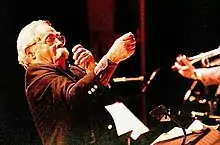Manny Albam
Manny Albam (June 24, 1922 – October 2, 2001) was an American jazz saxophonist, composer, arranger, record producer, and educator.[1][2]
Manny Albam | |
|---|---|
 Manny Albam conducting | |
| Background information | |
| Birth name | Emmanuel Albam |
| Born | June 24, 1922 Samana, Dominican Republic |
| Died | October 2, 2001 (aged 79) Croton-on-Hudson, New York, United States |
| Genres | Jazz, Latin jazz |
| Occupation(s) | Musician, arranger |
| Instruments | Saxophone |
| Labels | Solid State |
| Associated acts | Buddy Rich, Stan Kenton, Woody Herman |
Career
A native of the Dominican Republic, Albam grew up in New York City and was attracted to jazz at an early age when heard the music of Bix Beiderbecke.[3] He left school in his teens and played saxophone in a Dixieland band led by Muggsy Spanier. When he was with the Georgie Auld band, he learned about arranging with Budd Johnson.[3] By 1950 Albam was concentrating less on performing and more on writing and arranging. Within a few years, he became known for a bebop style that emphasized taut and witty writing with a flair for distinctive shadings; flute-led reed sections became something of an Albam trademark. One of his most popular works from that era was an Afro-Latin composition he did for the Stan Kenton Innovations Orchestra entitled "Samana", named after his birthplace in the Dominican Republic.[4] He worked with bandleaders Charlie Barnet and Charlie Spivak[3] before collaborating with Count Basie, Stan Getz, Bob Brookmeyer, Coleman Hawkins, Dizzy Gillespie, Freddie Hubbard, Hank Jones, Mel Lewis, Art Farmer, Urbie Green, and Milt Hinton.
Albam wrote arrangements for Leonard Bernstein's score for the musical West Side Story in 1957. The work earned him a Grammy Award nomination in 1959. He was invited by Bernstein to write for the New York Philharmonic, and he began to study classical music with Tibor Serly, eventually writing Quintet for Trombone and Strings. He also wrote music for movies, television, and commercials.[3] In the early 1960s he became music director for Solid State Records.[3] For the rest of his career, he taught at Glassboro State College, Eastman School of Music, and Manhattan School of Music.[3] He helped start and lead the BMI Jazz Composers Workshop.[3]
He died of cancer in Croton-On-Hudson, aged 79, in 2001.[5]
On June 25, 2019, The New York Times Magazine listed Manny Albam among hundreds of musicians whose material was reportedly destroyed in the 2008 Universal fire.[6]
Discography
As leader
- The Drum Suite (RCA Victor, 1956)
- The Jazz Workshop (RCA Victor, 1956)
- Manny Albam and the Jazz Greats of Our Time Vol. 1 (Coral, 1957)
- Sophisticated Lady (Coral, 1958)
- The Jazz Greats of Our Time Vol. 2 (Coral, 1958)
- The Blues Is Everybody's Business (Coral, 1958)
- Double Exposures (Top Rank, 1960)
- West Side Story (Vocalion, 1960)
- Jazz Goes to the Movies (Impulse!, 1962)
- Brass on Fire (Solid State, 1966)
- The Soul of the City (Solid State, 1966)
As arranger
With Count Basie
- Dance Session Album #2 (Clef, 1954)
- Basie (Clef, 1954)
With Kenny Clarke-Francy Boland Big Band
- Latin Kaleidoscope (MPS, 1968)
With Al Cohn
- Mr. Music (RCA Victor, 1955)
- The Natural Seven (RCA Victor, 1955)
- That Old Feeling (RCA Victor, 1955)
- Four Brass One Tenor (RCA Victor, 1955)
With Jose Feliciano
- Jose Feliciano Sings (RCA, 1972)
With Curtis Fuller
- Cabin in the Sky (Impulse!, 1962)
With Freddie Green
- Mr. Rhythm (RCA Victor, 1955)
With Coleman Hawkins
- The Hawk in Paris (Vek, 1956)
- Desafinado (Impulse!, 1962)
With Groove Holmes
- New Groove (Groove Merchant, 1974)
With O'Donel Levy
- Breeding of Mind (Groove Merchant, 1972)
- Dawn of a New Day (Groove Merchant, 1973)
- Simba (Groove Merchant, 1974)
With Jimmy McGriff
- The Big Band (Solid State, 1966)
- A Bag Full of Blues (Solid State, 1967)
With Joe Newman
- Salute to Satch (RCA Victor, 1956)
- I Feel Like a Newman (Storyville, 1956)
With Freda Payne
- After the Lights Go Down Low and Much More!!! (Impulse!, 1964)
With Oscar Peterson
- With Respect to Nat (Verve, 1965)
With Buddy Rich
- The Roar of '74 (RCA, 1974)
With Zoot Sims
- New Beat Bossa Nova (Colpix, 1962)
With Dakota Staton
- I Want a Country Man (Groove Merchant, 1973)
- Clean Head's Back in Town (Bethlehem, 1957)
With Dionne Warwick
- Dionne Warwick in Valley of the Dolls (Scepter, 1968)
See also
References
- Strunk, Steven; Kernfeld, Barry (2002). Barry Kernfeld (ed.). The New Grove Dictionary of Jazz Vol. 1 (2nd ed.). New York: Grove's Dictionaries. p. 24. ISBN 1561592846.
- Cook, Richard (2005). Richard Cook's Jazz Encyclopedia. London: Penguin Books. pp. 6. ISBN 0-141-00646-3.
- Ankeny, Jason. "Manny Albam". AllMusic. Retrieved 17 March 2020.
- Sparke, Michael (2010). Stan Kenton: This Is an Orchestra. UNT Press. p. 91.
- https://www.bmi.com/news/entry/20011009_jazz_great_manny_albam_dies_at_79
- Rosen, Jody (June 25, 2019). "Here Are Hundreds More Artists Whose Tapes Were Destroyed in the UMG Fire". The New York Times. Retrieved June 28, 2019.
External links
- Audio interview with Manny Albam at NAMM Oral History Library (1997)